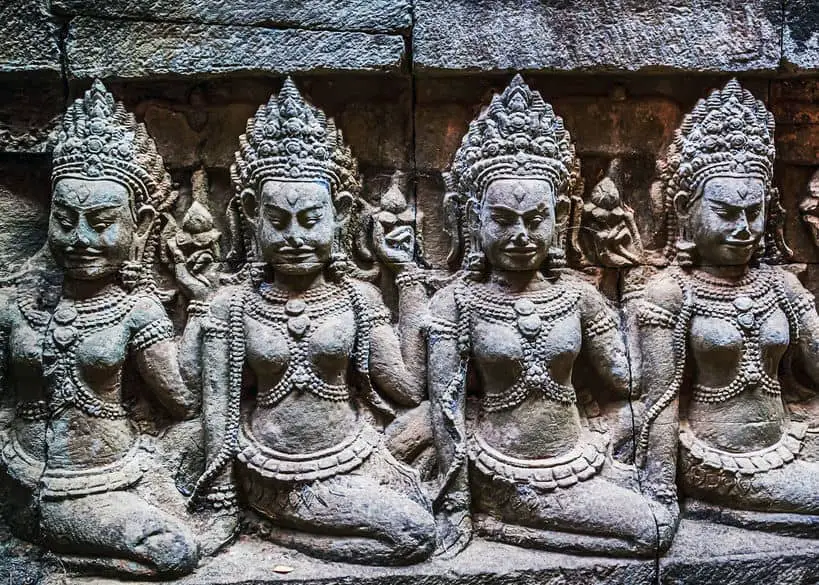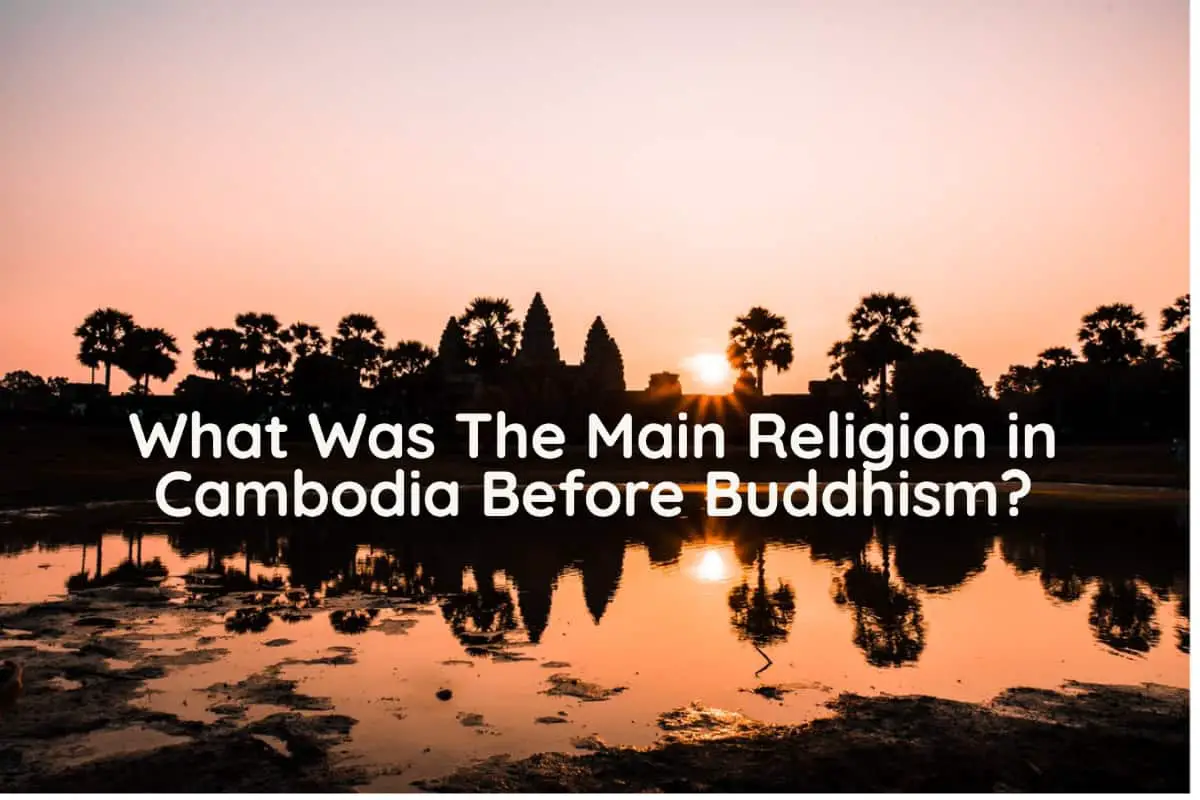One of my favorite places to visit is the country of Cambodia. Today Cambodia is a predominately Buddhist country, but that is not always the case.
Before Buddhism was so prevalent in Cambodia, the main religion was Hinduism. Hinduism was the state religion of Cambodia for over 1000 years. The Angkor Wat temple complex in Siem Reap, Cambodia, was originally built as a Hindu temple.
Table of Contents
- Cambodia’s Era of Hinduism
- Angkor Wat – Seat of A Once-Powerful Hindu Empire
- How To Visit Angkor Wat
- Related Questions
Cambodia today is about 95% Theravada Buddhist, even though much of Cambodia was founded on Hinduism’s religious principles.

Cambodia’s Era of Hinduism
Hinduism arrived in Cambodia as early as the 1st Century. It can be said Hinduism is the oldest, if not one, of the oldest religions in Cambodia.
Hinduism Arrives in Cambodia
We’re not sure of the exact date that Hinduism arrived in Cambodia, but we know it was during the 1st century. Indians from India’s coasts traveled to all parts of Southeast Asia, including Cambodia. During their travels, they brought Hinduism with them.
The arrival of Hinduism in Cambodia is an example of how so many Indians left their homeland during this era to travel to parts of Southeast Asia, They traveled as far away as some parts of the Philippines.
Hinduism had a profound effect on Cambodia and the entire cultural and historical development in Southeast Asia. This is why you may find that many temples or cultural relics have hints of Indian architecture and culture.
To understand Hinduism in Cambodia, you must also understand a little bit about this time frame of Cambodian history.
Funan Empire – 1st to 6th Centuries
We know that in the 1st to the 6th centuries, under what was known as the Kingdom of Funan, Cambodia, parts of Vietnam, and Thailand were practicing mainly Hinduism. In fact, from the 1st to the 6th centuries, Cambodia was part of what was known as the Funan Empire, which covered parts of Thailand, Cambodia, and Vietnam.
Funan is a Chinese name that was known to be in the Chinese annuals and used as a reference for this area. The visiting Chinese traders, scholars, and others reported back to China and used the name Funan to describe the government and people at this time,
During this period of time, many of the Funan Kings worshiped the Hindu gods Vishnu and Shiva. The people would have followed and worshiped the same religion that their king worshiped.
Chenla Empire – 6th to 9th Centuries
When the Funan Empire dissolved in 600 BC, the Chinese annals written by the Chinese traders, called the new empire Chenla, Chenla seemed to be a loosely defined group of different principalities without a central government.
Cambodia received a lot of this trade and visits from China and India as Cambodia has a strategic position where both the Indian and the East Asian traders would have merged. During their journeys, both the Chinese and Indians would have stopped off in Cambodia.

Listen To Our Podcast About What Was The Main Religion In Cambodia Before Buddhism? below or by clicking here.
Khmer Empire – Early 9th to 15th Centuries
What was known as the Khmer Empire was established in the 9th century. This is era is also known as the Angkor Empire and is still one of the proudest and most important times in Cambodian history.
During the Khmer Empire, Cambodia changed from worshipping mainly Hinduism to Buddhism. This change of religion happened partway through the Khmer empire.
The Khmer empire was a compelling period in Cambodian history. The influence of the Khmer empire stretched from Yunnan Province in Southern China to Vietnam to present-day Myanmar.
To understand how powerful the Khmer empire was, you only need to visit present-day Angkor Wat in Cambodia. This Khmer empire had so much wealth and power that they were able to build impressive structures like Angkor Wat.
During the peak of its power in the 11th to 13th centuries, the Angkor area and Angkor empire were one of the world’s largest urban centers of the time. Countries from all over Asia would flock to Angkor.

Angkor Wat – Seat of A Once-Powerful Hindu Empire
The Angkor Wat Park outside Siem Reap, Cambodia, is a testament to this once-great Hindu empire. The fact the Angkor temple was originally built as a Hindu temple can get lost in history. King Suryavarman II built the Angkor Wat Temple as a Hindu temple to honor the Hindu God Vishnu.
Emperor Suryavarman II
To visit Angkor Wat, you need to know Emperor Suryavarman II, the Khmer King, from 1113 AD to about 1145 -1150 AD. Emperor Suryavarman II was the builder and architect of the Angkor Wat Temple. Emperor Suryavarman II also practiced Hinduism, so he built Angkor Wat Temple to dedicate to the Hindu god Vishnu.
Why Suryavarman II dedicated the Angkor Wat Temple to the Hindu god Vishu, we do not know. Most of the previous rulers of Cambodia focused their Hinduism on the Hindu god Shiva.
When Emperor Suryavarman II died, he was posthumously given the name “Paramavishnuloka,” which means “He Who Entered The Heavenly World of Vishnu.”
Emperor Suryavarman II had a strong military force, organized government, and major architectural projects such as Angkor Wat during his reign. He is thought by many historians to be one of the greatest Khmer Emperors to ever live.
Emperor Suryavarman II spent a lot of time and effort in forcing military action with Champa, which is in present-day Vietnam. Most of this military action was not successful. There was a short period between 1145 and 1150 where there was some success, but it did not last long. Historians are unsure if King Suryavarman II died in one of those battles with Champa.
Emperor Suryavarman II was known as a great diplomat. He established formal diplomatic relations with China as early as 1116 Ad. This led to increased trade and commerce with China.
One of Emperor Suryavarman II greatest and most lasting achievements is the Angkor Wat Temple complex in present-day Siem Reap, Cambodia.

Angkor Wat
When people visit Angkor Wat outside Siem Reap, Cambodia, they may assume it is a Buddhist temple complex as Buddhism is so prevalent in Cambodia today. When you visit Angkor Wat, there are Buddhist monks throughout the temple complex.
Angkor Wat was originally built in the first half of the 12th century by Emperor Suryavarman II as a Hindu temple to worship and honor the Hindu god Vishnu.
In the Khmer language, Angkor Wat means “temple capital city.” Angkor means “capital city,” and Wat means “temple.” So literally, the name Angkor Wat meant the ” temple capital city” or simply “temple city.”
This “temple city,” also known as Angkor Wat, was built as a state temple and city complex that was the commerce and political center of the Khmer empire. In the heart of Angkor Wat city was the Angkor Wat temple, built to worship the Hindu god Vishnu.
Here are a few things about Angkor Wat and why King Suryavarman II built it originally as a Hindu temple:
- Khmer Architecture Masterpiece – Angkor Wat is a masterpiece of Khmer architecture, art, and culture.
- Largest Temple – The Angkor Wat Temple is the largest temple in the Angkor Wat complex.
- Faces West – The Angkor Wat temple faces west, the direction in which the Hindu god Vishnu is associated. Most Khmer temples face east.
- Five Towers – The five towers of the temple are said to represent the peaks of Mount Meru, which is known to be the home of the Hindu gods.
- Elaborate works of art – The temple has over 1,860 carved apsaras and hundreds of meters of bas-reliefs depicting Hindu legends and scenes from contemporary life.
- Relief of Emperor Suryavarman II – There is a bas-relief of Suryavarman II. He is the first Khmer Emperor to be depicted in art. This basrelief is on the south gallery of Angkor Wats walls and shows him seated on an elaborate wooden dai.
- Walls and Moats – A large moat and wall surround the temple. The walls and moats are said to honor the surrounding mountain ranges and sea.
- 200 acres – The original city of Angkor Wat stretched to more than 200 acres. This area was believed to have included the city, the temple structure, and the Emperor’s palace just north of the temple. This was indeed a temple within a great city. Only the temple was made of sandstone and the other structures were made of wood and other materials, so only the temple complex remains.
How To Visit Angkor Wat
Today you can visit Angkor Wat in Siem Reap, Cambodia. Many airlines have direct international flights into Siem Reap or you can easily get a connecting flight through Phnom Penh, Cambodia.
To visit the Angkor Wat temples and enter the Angkor Wat Park, you will need a valid pass. The passes are issued for a specific period of time. To find out more about Angkor Wat and the pass, you can visit the official Angkor Wat website by clicking here.
If you are planning a visit to Cambodia, particularly Angkor Wat, it is very good to understand Cambodia’s history and religious background. This will help you understand why Angkor Wat was built as a Hindu temple for the Hindu god Vishnu – particularly in a country over 95% Buddhist today.
At A Bus On A Dusty Road, we talk about travel, life, and ex-pat living. We are all about “Living Life As A Global Citizen.” We explore social, cultural, and economic issues and travel.
We would love to have you be part of our community. Sign up for our newsletter to keep up-to-date by clicking here. If you have any questions, you can contact me, Anita, by clicking here.
Listen to our Podcast called Dusty Roads. You can find it on all major podcast platforms. Try out listening to one of our podcasts by clicking here.
Subscribe to our A Bus On A Dusty Road YouTube Channel filled with great videos and information by clicking here.
Related Questions
Why Every Cyclist Should Ride Around Angkor Wat Cambodia?
Every cyclist should put cycling around the Angkor Wat temple complexes in Cambodia on their bucket list. It is not only one of the magnificent architectural wonders of the world but also a great way to see some amazing old temple complexes. When you cycle around Angkor Wat, you will have only the freedom to see it at your own pace, but you will also see things that you could never see in a car, bus, or even a tuk-tuk.
You can learn more by reading our blog Why Every Cyclist Should Ride Around Angkor Wat Cambodia? by clicking here.
What Is The Cambodian Krama Scarf?
The Cambodian Krama scarf is a gingham scarf that is not only used as a scarf but is also used as a bandanna, baby carrier, or even a blanket. Traditionally each Cambodian would hand-weave their scarf in cotton or silk. Many in the western world may recognize the red and white gingham scarf that the Khmer Rouge used when they ruled Cambodia.
You can discover more by reading our blog The Cambodian Krama Scarf, The Story Behind This Iconic Scarf by clicking here.

